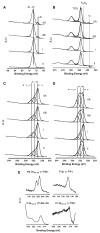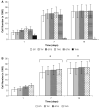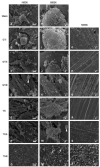In vitro evaluation of human osteoblast adhesion to a thermally oxidized gamma-TiAl intermetallic alloy of composition Ti-48Al-2Cr-2Nb (at.%)
- PMID: 20162332
- PMCID: PMC2871339
- DOI: 10.1007/s10856-010-4016-6
In vitro evaluation of human osteoblast adhesion to a thermally oxidized gamma-TiAl intermetallic alloy of composition Ti-48Al-2Cr-2Nb (at.%)
Abstract
Ti-48Al-2Cr-2Nb (at.%) (gamma-TiAl), a gamma titanium aluminide alloy originally designed for aerospace applications, appears to have excellent potential as implant material. Thermal treatment of gamma-TiAl renders this alloy extremely corrosion resistant in vitro, which could improve its biocompatibility. In this study, the surface oxides produced by thermal oxidation (at 500 degrees C, and at 800 degrees C for 1 h in air) on gamma-TiAl were characterized by X-ray photoelectron spectroscopy (XPS). hFOB 1.19 cell adhesion on thermally oxidized gamma-TiAl was examined in vitro by a hexosaminidase assay, scanning electron microscopy (SEM) and confocal laser scanning microscopy (CLSM) after 1, 7 and 14 days. Ti-6Al-4V surfaces were used for comparison. Hexosaminidase assay data and CLSM analysis of focal contacts and cytoskeleton organization showed no differences in cell attachment on autoclaved and both heat-treated gamma-TiAl surfaces at the different time points. SEM images showed well organized multi-layers of differentiated cells adhered on thermally oxidized gamma-TiAl surfaces at day 14. Unexpectedly, thermally oxidized Ti-6Al-4V surfaces oxidized at 800 degrees C exhibited cytotoxic effects on hFOB 1.19 cells. Our results indicate that thermal oxidation of gamma-TiAl seems to be a promising method to generate highly corrosion resistant and biocompatible surfaces for implant applications.
Figures







Similar articles
-
The effects of micro arc oxidation of gamma titanium aluminide surfaces on osteoblast adhesion and differentiation.J Mater Sci Mater Med. 2014 Jun;25(6):1577-87. doi: 10.1007/s10856-014-5179-3. Epub 2014 Feb 28. J Mater Sci Mater Med. 2014. PMID: 24577944 Free PMC article.
-
Corrosion evaluation of Ti-48Al-2Cr-2Nb (at.%) in Ringer's solution.Acta Biomater. 2006 Nov;2(6):701-8. doi: 10.1016/j.actbio.2006.05.012. Epub 2006 Aug 2. Acta Biomater. 2006. PMID: 16887397
-
Biocompatibility studies of human fetal osteoblast cells cultured on gamma titanium aluminide.J Mater Sci Mater Med. 2008 Jan;19(1):153-8. doi: 10.1007/s10856-006-0039-4. Epub 2007 Jun 28. J Mater Sci Mater Med. 2008. PMID: 17597368
-
Electron Beam Powder Bed Fusion of Ti-48Al-2Cr-2Nb Open Porous Scaffold for Biomedical Applications: Process Parameters, Adhesion, and Proliferation of NIH-3T3 Cells.3D Print Addit Manuf. 2024 Feb 1;11(1):314-322. doi: 10.1089/3dp.2022.0108. Epub 2024 Feb 15. 3D Print Addit Manuf. 2024. PMID: 38389689 Free PMC article.
-
Comparative analysis of corrosion resistance between beta titanium and Ti-6Al-4V alloys: A systematic review.J Trace Elem Med Biol. 2020 Dec;62:126618. doi: 10.1016/j.jtemb.2020.126618. Epub 2020 Jul 9. J Trace Elem Med Biol. 2020. PMID: 32663743
Cited by
-
Intestine Explants in Organ Culture: A Tool to Broaden the Regenerative Studies in Echinoderms.J Mar Sci Eng. 2022 Feb;10(2):244. doi: 10.3390/jmse10020244. Epub 2022 Feb 11. J Mar Sci Eng. 2022. PMID: 36284610 Free PMC article.
-
Antimicrobial Polymer-Peptide Conjugates Based on Maximin H5 and PEG to Prevent Biofouling of E. coli and P. aeruginosa.ACS Appl Mater Interfaces. 2020 Oct 14;12(41):46991-47001. doi: 10.1021/acsami.0c13492. Epub 2020 Sep 30. ACS Appl Mater Interfaces. 2020. PMID: 32937073 Free PMC article.
-
The effects of micro arc oxidation of gamma titanium aluminide surfaces on osteoblast adhesion and differentiation.J Mater Sci Mater Med. 2014 Jun;25(6):1577-87. doi: 10.1007/s10856-014-5179-3. Epub 2014 Feb 28. J Mater Sci Mater Med. 2014. PMID: 24577944 Free PMC article.
-
Physicochemical, morphological, and biological analyses of Ti-15Mo alloy surface modified by laser beam irradiation.Lasers Med Sci. 2019 Apr;34(3):537-546. doi: 10.1007/s10103-018-2626-2. Epub 2018 Sep 27. Lasers Med Sci. 2019. PMID: 30259335
-
Interaction of human osteoblast-like Saos-2 and MG-63 cells with thermally oxidized surfaces of a titanium-niobium alloy.PLoS One. 2014 Jun 30;9(6):e100475. doi: 10.1371/journal.pone.0100475. eCollection 2014. PLoS One. 2014. PMID: 24977704 Free PMC article.
References
-
- Khan MA, Williams RL, Williams DF. The corrosion behaviour of Ti–6Al–4V, Ti–6Al–7Nb and Ti–13Nb–13Zr in protein solutions. Biomaterials. 1999;20:631–7. - PubMed
-
- Li J, Sun M, Ma X, Tang G. Structure and tribological performance of modified layer on Ti6Al4V alloy by plasma-based ion implantation with oxygen. Wear. 2006;261:1247–52.
-
- MacDonald DE, Rapuano BE, Deo N, Stranick M, Somasundaran P, Boskey AL. Thermal and chemical modification of titanium–aluminum–vanadium implant materials: effects on surface properties, glycoprotein adsorption, and MG63 cell attachment. Biomaterials. 2004;25:3135–46. - PubMed
-
- Escudero ML, Muñoz-Morris MA, García-Alonso MC, Fernández-Escalante E. In vitro evaluation of a γ-TiAl intermetallic for potential endoprothesic applications. Intermetallics. 2004;12:253–60.
-
- Delgado-Alvarado C, Sundaram PA. Corrosion evaluation of Ti–48Al–2Cr–2Nb (at.%) in Ringer’s solution. Acta Biomater. 2006;2:701–8. - PubMed
Publication types
MeSH terms
Substances
Grants and funding
LinkOut - more resources
Full Text Sources

